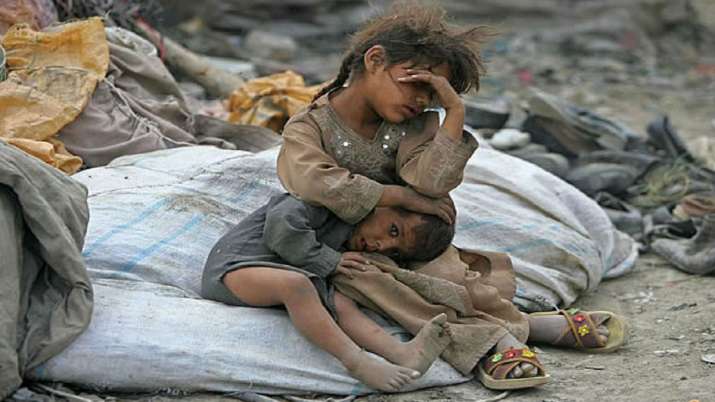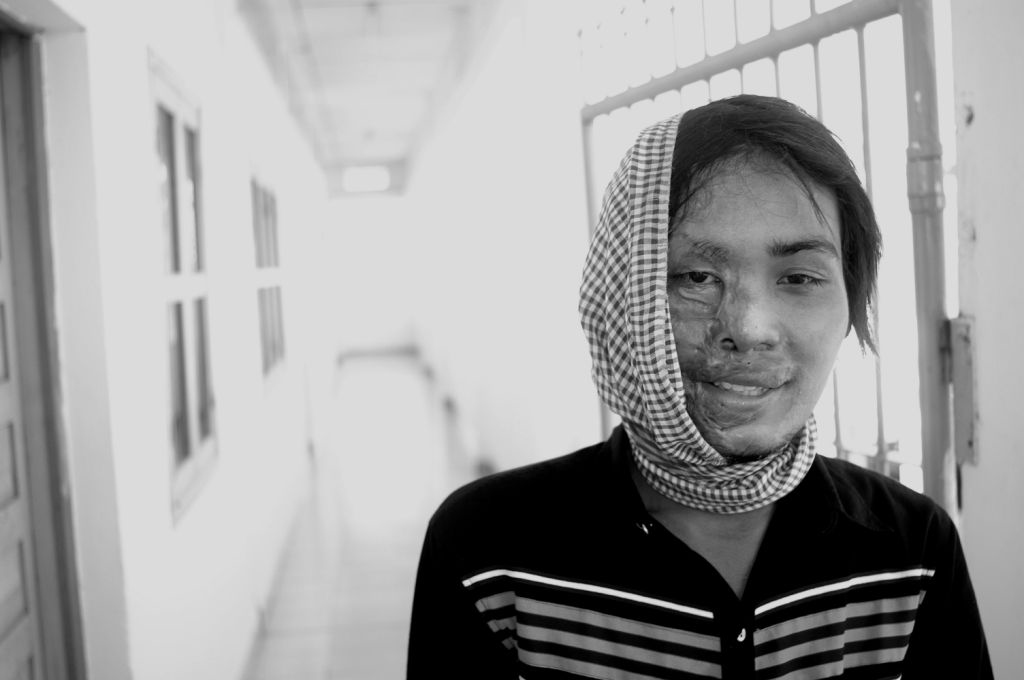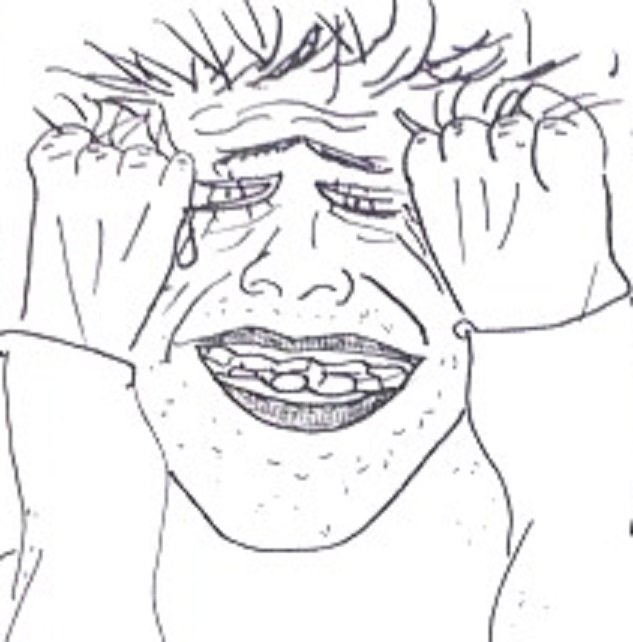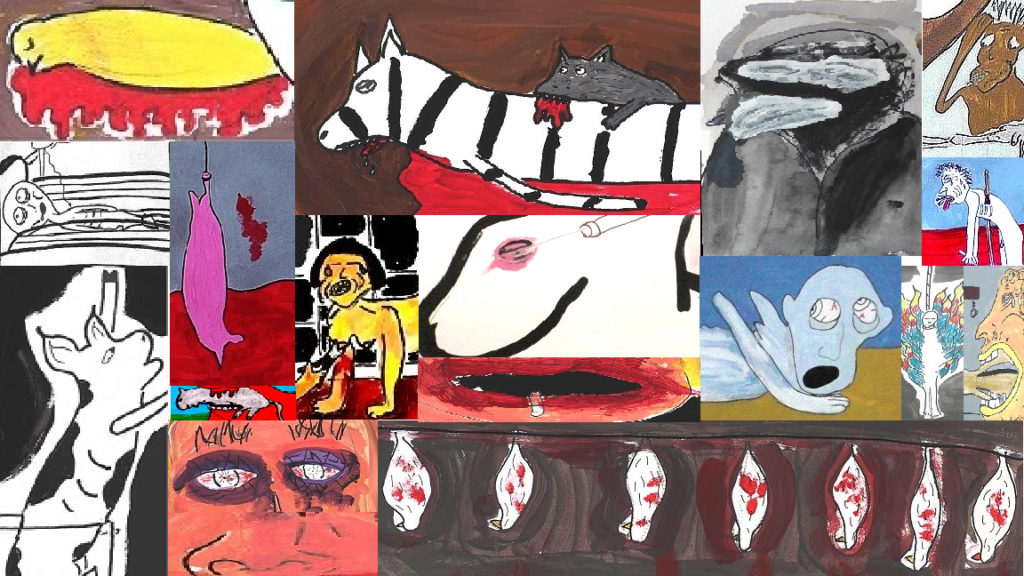Remember Suffering in this World
It’s not easy to think about intense suffering. It can make you feel helpless knowing that there’s so much pain in the world, going on all the time. But it’s important to stay cognizant, so we don’t forget the urgency of alleviating this suffering. Only when we know how much excruciating pain is out there, and how bad it is, can we resolve to do something to prevent it, and help those that can’t even find the breath to cry out:
- Lack of Access to Palliative Care and Pain Relief
- Cluster Headaches
- RSD/CRPS
- SUNA/SUNCT
- Trigeminal Neuralgia
- Sickle Cell Disease
- Cancer Pain
- Kidney Stone Pain
- Chronic Pain
- Poverty, Malnutrition, and Disease
- Violence against Women
- Modern Slavery
- Female Genital Mutilation/Circumcision
- Torture
- Mental Illness
Human Suffering
Lack of Access to Palliative Care and Pain Relief
“Annually, more than 61 million people worldwide experience about 6 billion days of serious health-related suffering that could be alleviated with access to palliative care and pain relief.”1
“All patients deserve access to the medical care they need to live with dignity and without pain, and that includes access to medically appropriate pain medication”2 – Stephen Clark
“Only 17% of the morphine produced worldwide in 2020 for medical purposes was consumed in low- and middle-income countries, despite them being home to close to 83% of the global population, according to the latest figures from the International Narcotics Control Board, which monitors drug use. It said the imbalance in usage has barely changed in 20 years.”3
Further Reading:
https://www.ncbi.nlm.nih.gov/pmc/articles/PMC6301382/
Cluster Headaches
- “Cluster headaches, which occur in cyclical patterns or cluster periods, are one of the most painful types of headache. A cluster headache commonly awakens you in the middle of the night with intense pain in or around one eye on one side of your head.”4
- “. . .sufferers are reported to have suicide rates about 20x the average. . .Cluster headaches affect about 0.1% of the total population at some point, though one review puts the figure at 0.2-0.3%, meaning that approximately 8-20 million people globally will suffer from cluster headaches.”5
Further Reading:
www.preventsuffering.org/cluster-headaches/
www.nhs.uk/conditions/cluster-headaches/
Reflex Sympathetic Dystrophy/Complex Regional Pain Syndrome
“Both RSD and CRPS are chronic conditions characterized by severe burning pain, most often affecting one of the extremities (arms, legs, hands, or feet). There are often pathological changes in bone and skin, excessive sweating, tissue swelling and extreme sensitivity to touch, known as allodynia.”6
“Complex regional pain syndrome (CRPS) is a condition which is difficult to diagnose, difficult to treat, and unlike other chronic pain conditions, it can spread to encompass other parts of the body.8, 32, 48 It is reputed to be the most painful condition known to man as measured by the McGill Pain scale, rating higher than amputation of a digit, childbirth and cancer pain.8, 32, 59“7
“Epidemiological data from 2 major studies show a CRPS incidence between 5.577 and 26.2 cases25 per 100,000 people per year.”8
Further Reading:
https://www.health.ny.gov/diseases/chronic/reflex_sympathetic/
www.rsds.org/telltale-signs-and-symptoms-of-crpsrsd/
SUNA/SUNCT
“SUNCT and SUNA involve pain of moderate to severe intensity that occurs around one eye or temple in bursts of five seconds to five minutes per episode. Attacks usually always happen during the daytime. People with these headache disorders may have multiple attacks within an hour and as many as 3 to 200 attacks in one day. The pain can feel like burning, stabbing, throbbing or electric.”9
“The prevalence is estimated at approximately 1 in 15,000. It is slightly more predominant in males (male-to-female ratio of 1.5:1), with a mean age of onset of around 50 years. A few cases of SUNCT/SUNA syndrome have been reported in children.”10
Further Reading:
Trigeminal Neuralgia
“Trigeminal neuralgia is a condition that causes painful sensations similar to an electric shock on one side of the face. . . If you have trigeminal neuralgia, even mild stimulation of your face — such as from brushing your teeth or putting on makeup — may trigger a jolt of excruciating pain.”
“If you have trigeminal neuralgia, even mild stimulation of your face — such as from brushing your teeth or putting on makeup — may trigger a jolt of excruciating pain.”11
“Trigeminal neuralgia (TN) is not easily controlled and there is no cure. It is estimated that 1 in 15,000 people suffer from trigeminal neuralgia, although the actual figure may be significantly higher due to frequent misdiagnosis.”12
Further Reading:
Trigeminal Neuralgia Fact Sheet | National Institute of Neurological Disorders and Stroke (nih.gov)
Sickle-Cell Disease Pain
“A sickle cell crisis is pain that can begin suddenly and last several hours to several days. It happens when sickled red blood cells block small blood vessels that carry blood to your bones. You might have pain in your back, knees, legs, arms, chest or stomach. The pain can be throbbing, sharp, dull or stabbing.”13
“I am 71 y/o with sickle-thal rather than SCD, and I am usually hospitalized twice a year to manage painful crises. What does it feels like? A SEVERE, sharp,throbbing,aching,pain. It’s like having an excruciating toothache wherever it locates, usually in the arms,legs,back,or chest. When my pain meds, hot baths, heating pads don’t work to alleviate the pain,I’ll go to the hospital where I can get stronger painkillers (dilaudid, morphine, etc.) and intravenous hydration to reduce the pain. Not fun!”14
Further Reading:
Complications of Sickle Cell Disease | CDC
Cancer Pain
“When a tumor spreads to the spine, it can press on the nerves of the spinal cord. This is called spinal cord compression. The first symptom of spinal cord compression is usually back and/or neck pain, and sometimes it is severe. Pain, numbness, or weakness may also happen in an arm or leg. Coughing, sneezing, or other movements often make the pain worse.”15
“For the last 9 months a cancer has progressed without being diagnosed and now I am in bed with pains, yellow stools, headaches, unable to eat and drink. Yet I am due for a test next week when the system and myself let me down so much that I can hardly walk.
I want to commit suicide to finish it off, the pains and all.”16
Further Reading:
Facts About Cancer Pain | Pain from Cancer & Cancer Treatment
Kidney Stone Pain
“Researchers have concluded that about one in ten people will get a kidney stone during their lifetime.”17
“Kidney stone pain — also known as renal colic — is one of the most severe types of pain imaginable. Some people who’ve experienced kidney stones compare the pain to childbirth or getting stabbed with a knife.”
“The pain is intense enough to account for more than half a million visits to emergency rooms each year.”18
Further Reading:
https://moreisdifferent.substack.com/p/weird-cause-area-1-kidney-stone-pain?s=r
https://en.wikipedia.org/wiki/Renal_colic
Chronic Pain
- “Globally, it is estimated that about one in five, or about 1.5 billion people, suffer from chronic pain (CP), with prevalence increasing with age. Arthritis, nerve damage, and cancer pain are the leading causes of CP.”19
Further Reading:
https://www.hopkinsmedicine.org/health/conditions-and-diseases/chronic-pain
https://www.webmd.com/pain-management/ss/slideshow-brace-yourself
Poverty, Malnutrition, and Disease
- “At least 14 million children suffer from severe acute malnutrition around the world. Severe acute malnutrition is the direct cause of death for 2 million children every year.”
- “Every day, 1,000 children under 5 die from illnesses like diarrhea, dysentery, and cholera caused by contaminated water and inadequate sanitation.”20
- “Within low- and middle-income countries (LMICs), absolute socioeconomic deprivation and socioeconomic gradients among populations are both important determinants of health “21

Further Reading:
The Intertwined Relationship Between Malnutrition and Poverty – PMC (nih.gov)
Fact sheets – Malnutrition (who.int)
Physical and Sexual Violence against Women
- “Estimates published by WHO indicate that globally about 1 in 3 (30%) of women worldwide have been subjected to either physical and/or sexual intimate partner violence or non-partner sexual violence in their lifetime.”22
“Acid throwing, also called acid attack, or vitriolage, is defined as the act of throwing acid onto the body of a person “with the intention of injuring or disfiguring [them] out of jealousy or revenge”.[119] The most common types of acid used in these attacks are sulfuric, nitric, or hydrochloric acid.[120] Perpetrators of these attacks throw acid at their victims, usually at their faces, burning them, and damaging skin tissue, often exposing and sometimes dissolving the bones.[121] The long term consequences of these attacks include blindness and permanent scarring of the face and body.[122][123] Women and girls are the victims in 75-80% of cases.[124] Acid attacks are often connected to domestic disputes, including dowry disputes, and refusal of a proposal of marriage, or of sexual advances.”23

Further Reading:
What we do: Ending violence against women | UN Women – Headquarters
Facts and figures: Ending violence against women | What we do | UN Women – Headquarters
Modern Slavery
- “40 million people are estimated to be trapped in modern slavery worldwide:
- 1 in 4 of them are children.
- Almost three quarters (71%) are women and girls.”
- “Modern slavery is all around us, but often just out of sight. People can become entrapped making our clothes, serving our food, picking our crops, working in factories, or working in houses as cooks, cleaners or nannies.”24
Further Reading:
What is modern slavery? | Anti-Slavery International (antislavery.org)
Female Genital Mutilation/Circumcision
“Seen from a human rights perspective, the practice reflects deep-rooted
inequality between the sexes, and constitutes an extreme form of discrimination against women. Female genital mutilation is nearly always carried out on minors and is therefore a violation of the rights of the child. The practice also violates the rights to health, security and physical integrity of the person, the right to be free from torture and cruel, inhuman or degrading treatment, and the right to life when the procedure results in death.”25
“It is estimated that more than 200 million girls and women alive today have undergone female genital mutilation in the countries where the practice is concentrated. Furthermore, there are an estimated 3 million girls at risk of undergoing female genital mutilation every year. The majority of girls are cut before they turn 15 years old.”26
Further Reading
Torture
- “We are witnessing a global crisis on torture. Over the last five years, Amnesty International has reported on torture in 141 countries – three-quarters of the world.
- “Tens of thousands of people fall victim to the ravages of torture every year. An estimated 400,000 torture survivors live in the United States today. Studies have estimated that up to 30 percent of all refugees are torture survivors.”27
- Torture survivors throughout the world exhibit similar symptoms, including chronic
pain in muscles and joints, severe depression and anxiety, intense and incessant nightmares, guilt and self-hatred, impaired memory, the inability to concentrate, the
inability to form and maintain meaningful relationships, and frequent thoughts of
suicide.”28
Further Reading:
Torture | Human Rights Watch (hrw.org)
Torture – Amnesty International
Mental Illness
- “Around 20% of the world’s children and adolescents have a mental health condition, with suicide the second leading cause of death among 15-29-year-olds. Approximately one in five people in post-conflict settings have a mental health condition.”29
- “People with mental health conditions experience widespread human rights violations, discrimination and stigma. More than 80% of people experiencing mental health conditions, including individuals experiencing neurological and substance use disorders, are without any form of quality, affordable mental health care.”30
Further reading
Mental Health – Our World in Data
Non-human Animal Suffering
Factory Farming
“When routine factory farming practices are taken into consideration, such as separating mother cows from infants, which often results in mothers crying for days; castrating male animals without anesthetics; or never once allowing animals to experience the outdoors—save for a terrifying journey in the back of a truck on the way to the slaughterhouse—there is little about the experience of farmed animals in the factory farming system that appears to be humane.”31
“The UN has warned that if we continue as we are, the world’s soils will have effectively gone within 60 years. And then what? We shouldn’t look to the sea to bail us out because commercial fisheries are expected to be finished by 2048 …”32
Further reading
Factory Farming: What It Is and Why It’s a Problem (thehumaneleague.org)
Vivisection
“Over 100 million animals are burned, crippled, poisoned, and abused in US labs every year.”
“Several cosmetic tests commonly performed on mice, rats, rabbits, and guinea pigs include: skin and eye irritation tests where chemicals are rubbed on shaved skin or dripped into the eyes without any pain relief.”33
Further reading
Homepage | National Anti-Vivisection Society (navs.org)
Entertainment-Rodeos, Circuses, Horseracing, and Zoos
“Rodeos may be popular, but more and more Americans are becoming aware of just how cruel these events are for the animals forced to participate. The horses, bulls, steer, and calves suffer broken ribs, backs, and legs, torn tails, punctured lungs, internal organ damage, ripped tendons, torn ligaments, snapped necks, and agonizing deaths.”34
“Frustrated by years of beatings, bullhooks, and shackles, some elephants snap. In more than 35 dangerous incidents since 2000, elephants have bolted from circuses, crashed into buildings, attacked members of the public, and killed and injured handlers.”
“Horses are often injected with cocaine and other illegal drugs to disguise the pain they might feel during races.”35
Further reading:
Animals in Entertainment: Circuses, SeaWorld, and Beyond | PETA
Puppy Mills
“Many puppy mills do not practice humane euthanasia. Dogs are killed in cruel ways, including shooting or drowning.”
- “Over 2 million puppies bred in mills each year.
- An estimated 1.2 million dogs are euthanized in shelters every year.”36
Further reading:
Stopping Puppy Mills | The Humane Society of the United States
Fur
“Every year, around 100 million animals are raised and killed for their fur. Over 95% of fur sold globally, comes from farmed animals, such as mink, foxes, raccoon dogs, rabbits and chinchillas.”
“On fur factory farms, animals spend their entire lives in cramped battery cages, deprived of the ability to engage in natural behaviours.”
“
Numerous scientific reports have indicated that severe health problems are inherent to fur production and that animals on all fur farms have been found to exhibit physical and behavioral abnormalities as:
“…infected wounds, missing limbs from biting incidents, eye infections, bent feet, mouth deformities, self-mutilation, cannibalism of dead siblings or offspring and other stress-related stereotypical behaviour.’“37
Further reading:
Fur Farming – Animal Welfare Problems (furfreealliance.com)
Wild Animal Suffering
“I cannot persuade myself that a beneficent and omnipotent God would have designedly created the Ichneumonidæ with the express intention of their feeding within the living bodies of Caterpillars, or that a cat should play with mice.”38 – Charles Darwin
“Wild animal suffering is the suffering experienced by nonhuman animals living outside of direct human control, due to harms such as disease, injury, parasitism, starvation and malnutrition, dehydration, weather conditions, natural disasters, and killings by other animals, as well as psychological stress.”39
“The suffering of animals from predators, disease, and starvation is truly massive in scale. By one estimate, some 24 billion animals are alive and being raised for meat at any given time. We have only the vaguest idea of how many wild animals there might be in the world, but we know the number is high: anywhere from 100 billion to 1 trillion mammals, at least 10 trillion fish, and another 100 to 400 billion birds.”40
Further reading:
Wild animal suffering – Wikipedia
Why wild animal suffering matters — Animal Ethics (animal-ethics.org)
Conclusion
“I’m better fueled to act when I stave off the cold of borrowed sorrow, staying warm with good feelings of caring & love.”
Phoenix Huber
Being there for others gives meaning to life. Helping others gives meaning to life. There is no greater cry for help than from someone who is suffering. This list is a non-comprehensive catalogue of intense suffering. It is not meant to overwhelm the reader, but rather to inspire folks to work for the betterment of the conditions of those enduring incredible pain. We need to build a community of Suffering-reducing Carers; i.e., folks who think of ethics not as the description of how autarkical individuals navigate abstract moral dilemmas, but how people ought to respond to distress in this messy, interdependent world where life is “dependent on connection, as sustained by activities of care. . .seeing and responding to need, taking care of the world by sustaining the web of connection. . .the vision that everyone will be responded to and included, that no one will be left alone or hurt.”41 This is the vision of Care Ethics in general, and also of Suffering-focused Care Ethics. The most compassionate action is reducing suffering, and by strengthening our mutual and institutional capacity to respond with empathetic love to those suffering, we prepare ourselves to help those that need us most.
Further Reading:
Suffering-Focused Ethics (SFE) FAQ – EA Forum (effectivealtruism.org)
Care Ethics Research Consortium – Commitment to Care (care-ethics.com)
SAbo | Suffering Abolition (suffering-abolition.github.io)
Care Ethics | Internet Encyclopedia of Philosophy (utm.edu)
Organisation for the Prevention of Intense Suffering (OPIS) (preventsuffering.org)
Citations
- Bhadelia, Lima, Arreola-Ornelas, Kwete, and Felicia Marie Knaul. “Solving the Global Crisis in Access to Pain Relief: Lessons From Country Actions.” Am J Public Health, 2019 January; 109(1): 58–60. National Library of Medicine, https://www.ncbi.nlm.nih.gov/pmc/articles/PMC6301382/. Accessed 3 August 2022.
- The Guardian. “US attack on WHO ‘hindering morphine drive in poor countries'” The Guardian, https://www.theguardian.com/society/2019/sep/18/us-attack-world-health-organization-who-hindering-morphine-drive-poor-countries. Accessed October 10 2022.
- The Guardian. “Pain-relief shortage in poorer countries ‘due to stigma of US opioids crisis’.” theguardian.com, https://www.theguardian.com/global-development/2022/aug/04/pain-relief-drugs-shortage-poorer-countries-us-opioids-crisis-acc. Accessed September 2 2022.
- Mayo Clinic. “Cluster headache.” Mayo Clinic, https://www.mayoclinic.org/diseases-conditions/cluster-headache/symptoms-causes/syc-20352080. Accessed 3 August 2022.
- Organization for the Prevention of Intense Suffering. “CLUSTER HEADACHES: IMPROVING ACCESS TO EFFECTIVE TREATMENTS.” OPIS, https://www.preventsuffering.org/cluster-headaches/. Accessed 3 August 2022.
- New York State Department of Health. “Reflect Sympathetic Dystrophy Syndrome[Complex Regional Pain Syndrome].” health.ny.gov, https://www.health.ny.gov/diseases/chronic/reflex_sympathetic/. Accessed 3 August 2022.
- Johnston-Devin Colleen, Oprescu Florin, Gray Marion, Wallis Marianne. “Patients Describe their Lived Experiences of Battling to Live with Complex Regional Pain Syndrome.” The Journal of Pain, Volume 22, Issue 9, September 2021, Pages 1111-1128. sciencedirect.com, https://www.sciencedirect.com/science/article/pii/S1526590021002029. Accessed October 28 2022.
- Birklein, Frank*; Dimova, Violeta. “Complex regional pain syndrome–up-to-date.” Pain Reports, vol. 2, iss. 6, 2017,https://journals.lww.com/painrpts/fulltext/2017/12000/complex_regional_pain_syndrome_up_to_date.8.aspx. Accessed 8 September 2022.
- American Migraine Foundation. “What are SUNCT and SUNA?” American Migraine Foundation, What Are SUNCT and SUNA? | American Migraine Foundation. Published December 9 2022. Accessed October 15 2022.
- Orphanet. “SUNCT syndrome.” Orpha.net, Orphanet: SUNCT syndrome. Accessed October 16 2022.
- Mayo Clinic. “Trigeminal Neualgia.” mayoclinic.org, https://www.mayoclinic.org/diseases-conditions/trigeminal-neuralgia/symptoms-causes/syc-20353344. Accessed August 30 2022.
- UR Medecine. “Trigeminal Neuralgia.” urmc.rochester.edu, https://www.urmc.rochester.edu/neurosurgery/services/conditions/trigeminal-neuralgia.aspx. Accessed August 30 2022.
- Centers for Disease Control and Prevention. “Stories of Sickle Cell: Short Stories.” cdc.gov, https://www.cdc.gov/ncbddd/sicklecell/stories.html. Accessed October 16 2022.
- Jacqueline. “Describe a Sickle Cell Crisis. sicklecellanemianews.com, https://sicklecellanemianews.com/forums/forums/topic/describe-a-sickle-cell-crisis/. Accessed October 20 2022.
- American Cancer Association. “Facts About Cancer Pain.” cancer.org, https://www.cancer.org/treatment/treatments-and-side-effects/physical-side-effects/pain/facts-about-cancer-pain.html. Accessed 9 September 2022.
- Kalw. “Want to commit suicide but can’t because of religion.” cacnerresearckuk.org, https://www.cancerresearchuk.org/about-cancer/cancer-chat/thread/want-to-commit-suicide-but-cant-because-of-religion. Accessed October 20 2022.
- Cleveland Clinic. “Kidney Stones.” Cleveland Clinic, https://my.clevelandclinic.org/health/diseases/15604-kidney-stones. Accessed 8 August 2022.
- Healthline. “8 Signs and Symptoms of Kidney Stones.” healthline.com, https://www.healthline.com/health/symptoms-of-kidney-stones. Accessed 8 August 2022.
- Boston University School of Public Health. “Chronic Pain and the Health of Populations.” bu.edu, https://www.bu.edu/sph/news/articles/2017/chronic-pain-and-the-health-of-populations/. Accessed 8 August 2022.
- Action Against Hunger. “GLOBAL POVERTY AND HUNGER.” actionagainsthunger.org, https://www.actionagainsthunger.org/global-poverty-hunger-facts. Accessed 8 August 2022.
- Coates MM, Ezzati M, Robles Aguilar G, Kwan GF, Vigo D, Mocumbi AO, et al. (2021) Burden of disease among the world’s poorest billion people: An expert-informed secondary analysis of Global Burden of Disease estimates. PLoS ONE 16(8): e0253073. https://doi.org/10.1371/journal.pone.0253073
- World Health Organization. “Violence against women.” who.int, https://www.who.int/news-room/fact-sheets/detail/violence-against-women. Accessed 9 August 2022.
- Wikipedia. “Violence against women.” en.wikipedia.org, Violence against women – Wikipedia. Accessed October 28 2022.
- anti-slavery. “What is modern slavery?” antislavery.org, https://www.antislavery.org/slavery-today/modern-slavery/. Accessed 9 August 2022.
- https://www.un.org/womenwatch/daw/csw/csw52/statements_missions/Interagency_Statement_on_Eliminating_FGM.pdf
- https://www.who.int/teams/sexual-and-reproductive-health-and-research-(srh)/areas-of-work/female-genital-mutilation/prevalence-of-female-genital-mutilation
- Amnesty International. “Torture.” amnesty.org, https://www.amnesty.org/en/what-we-do/torture/. Accessed 9 August 2022.
- Dross, Peter. “Survivors of Politically Motivated Torture: A Large, Growing, and Invisible Population of Crime Victims.” Office for Victims of Crime, ncjrs.gov, https://www.ncjrs.gov/ovc_archives/reports/motivatedtorture/torture.pdf. Accessed 9 August 2022.
- World Health Organization. “Mental Health.” who.int, https://www.who.int/health-topics/mental-health#tab=tab_2. Accessed 9 August 2022.
- World Health Organization. “The WHO Special Initiative for Mental Health (2019-2023):Universal Health Coverage for Mental Health.” apps.who.int, https://apps.who.int/iris/bitstream/handle/10665/310981/WHO-MSD-19.1-eng.pdf?sequence=1&isAllowed=y. Accessed 9 August 2022.
- The Humane League. “FACTORY FARMING: WHAT IT IS AND WHY IT’S A PROBLEM.” thehumaneleague.org, https://thehumaneleague.org/article/what-is-factory-farming. Accessed August 23, 2022.
- van der Zee, Bibi. “Why factory farming is not just cruel – but also a threat to all life on the planet.” theguardian.com, https://www.theguardian.com/environment/2017/oct/04/factory-farming-destructive-wasteful-cruel-says-philip-lymbery-farmageddon-author. Accessed August 23, 2022.
- DOSomething.org. “11 FACTS ABOUT ANIMAL TESTING.” dosomething.org, https://www.dosomething.org/us/facts/11-facts-about-animal-testing. Accessed August 23, 2022.
- Animal Legal Defense Fund. “Rodeo Facts. The Case Against Rodeos.” aldf.org, https://aldf.org/article/rodeo-facts-the-case-against-rodeos/. Accessed August 23, 2022.
- Dosomething.org. “11 FACTS ABOUT ANIMALS IN ENTERTAINMENT.” dosomething.org, https://www.dosomething.org/us/facts/11-facts-about-animals-entertainment. Accessed OCtober 28 2022.
- The Puppy Mill Project. “About Puppy Mills.” thepuppymillproject.org, https://www.thepuppymillproject.org/about-puppy-mills/. Accessed October 28 2022.
- fur free Alliance. “Fur Farming.” furfreealliance.com, https://www.furfreealliance.com/fur-farming/. Accessed October 28 2022.
- Darwin, Charles. “Wild animal suffering.”Wikiquote, en.wikiquote.org, https://en.wikiquote.org/wiki/Wild_animal_suffering. Accessed October 28 2022.
- Wikiquote. “Wild Animal Suffering.” en.wikiquote.org, https://en.wikipedia.org/wiki/Wild_animal_suffering. Accessed October 28 2022.
- Matthews, Dylan. “The wild frontier of animal welfare.” Vox, https://www.vox.com/the-highlight/22325435/animal-welfare-wild-animals-movement. Accessed October 28 2022.
- GIlligan, Carol. In a Different Voice. Cambridge Massachusetts and London England, Harvard University Press, 1982.
Videos and Image Credits
- Human Rights Watch. “Morocco: Thousands Face Needless Suffering at End of Life.” Youtube, 4 February 2016, https://www.youtube.com/watch?v=aHnKX_gzLIg.
- Al Jazeera English. “Freedom from Pain – People & Power.” Youtube, 21 July 2011, https://www.youtube.com/watch?v=QOmEQGvgq4A.
- BBC News. “Cluster headaches: ‘Like someone is grabbing your face’ – BBC News.” Youtube, 6 may 2017, https://www.youtube.com/watch?v=OO5oDaG45kE.
- RSDSA. “The Experience and Impact of Having CRPS and the Need for Early Diagnosis & Treatment – RSDSA.” Youtube, 1 May 2014, https://www.youtube.com/watch?v=b49DtFigbbw.
- Pushkar Panzhani. “SUNCT/SUNA | Clinical features | Investigations | Treatment |” Youtube, SUNCT/SUNA | Clinical features | Investigations | Treatment | – YouTube. 3 Oct 2020.
- WCNC. “Rock Hill woman shares heartbreaking experience with Trigeminal neuralgia, known as ‘suicide dis.” Youtube, 29 Apr 2020, https://www.youtube.com/watch?v=hq2SSjXSUBQ.
- Pathways Pain Relief. “The Global Chronic Pain Crisis Explained.” Youtube, 23 June 2018, https://www.youtube.com/watch?v=CLHweLc3470.
- Food and Agricultural Organization of the United Nations. “State of Food Security and Nutrition in the World 2022.” Youtube, https://www.youtube.com/watch?v=9rkE-gAUhBk.
- tearsflow.blogspot.com. “Real & Incomplete Sad Love Stories: Short but true story of a poor family – Surely will make you cry “Read and share to others” (tearsflow.blogspot.com).”
- CGTN. “WHO reports 1 in 3 women in the world face violence.” Youtube, 10 March 2021, WHO reports 1 in 3 women in the world face violence.
- Sand Paper. “Acid attack victim.jpg” commons.wikimedia.org, https://commons.wikimedia.org/wiki/File:Acid_attack_victim.jpg/ https://creativecommons.org/licenses/by-sa/2.0/deed.en
- BBC News. “‘My life as a modern day slave’ – BBC News.” Youtube, 3 January 2018, https://www.youtube.com/watch?v=59KGc6UyjAw.
- Global Citizen. “The Truth About Female Genital Mutiliation.” Youtube, 26 February 2016, https://www.youtube.com/watch?v=WJwP6C5q6Qg.
- UNFPA East and Southern Africa. “FGM: No More!” Youtube, 6 July 2020, https://www.youtube.com/watch?v=EG9NuDF1n7o.
- Wonky Films. “Amnesty International – Torture.” Youtube, 20 October 2016, https://www.youtube.com/watch?v=S_y7XPOCGZM.
- The Humane League. “Life on Factory Farms: Neglect.” Youtube, 17 May 2019.
- NowThis News. “Tilapia Are Suffering at Factory Farms, Investigation Reveals.” Youtube, https://www.youtube.com/watch?v=SA2NpTAli20.
- Ärzte gegen Tierversuche. “The failure of animal experiments – an animated educational film.” Youtube, https://www.youtube.com/watch?v=Mo25wUKNySg. Accessed August 25 2022.
- PETA. “Life for Animals at Roadside Zoos and in Circuses Is Tragic.” Youtube, 30 June 2021, https://www.youtube.com/watch?v=Y6sikdjjPnU.
- The Humane Society of the United States. “Finland fur investigation reveals cruelty.” Youtube, 23 November 2021. https://www.youtube.com/watch?v=JivvVZBxY30.
- Animal Ethics. “What is wild animal suffering?” Youtube, 11 April 2020, https://www.youtube.com/watch?v=OYJi9zLBjaI.
- Meilleurs Animaux. “20 Minutes Wild Animals Eating Newborn Preys Alive Moments.” Youtube, 10 May 2022, https://www.youtube.com/watch?v=sikNDtOvIR0.
- Al Jazeera English. “Zimbabwe drought: Hundreds of animals die in National park.” Youtube, 12 November 2019, https://www.youtube.com/watch?v=Q2U_RZ4fNRs.
- Animal Ethics. “Diseases and parasitism.” Youtube, 25 April, 2020.


